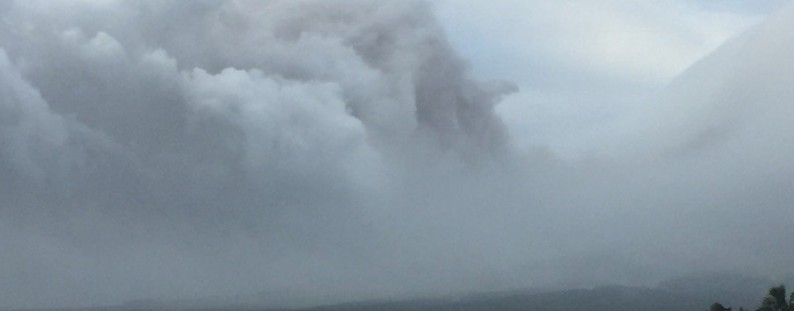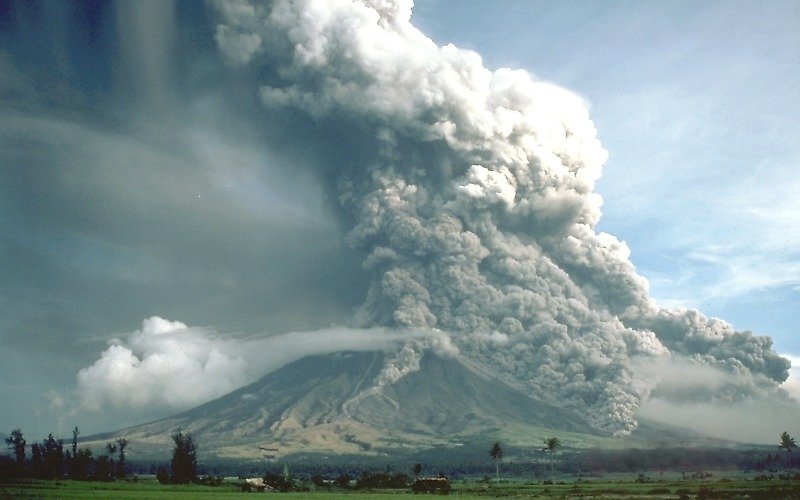Mayon volcano erupts after 3 years of calm, evacuation in progress, Philippines

A strong phreatic eruption started at Mayon volcano, Philippines at 09:06 UTC (17:06 local time) on Saturday, January 13, 2018. The eruption produced a column of ash reaching up to 5.2 km (17 000 feet) above sea level. The eruption was ongoing as of 10:06 UTC, although not visible in satellite imagery due to a meteorological cloud. The last eruption of this volcano took place in 2014.
Ashfall was reported in the towns SW of the volcano, Camalig and Guinobatan, while residents in towns near the volcano reported rumbling sounds and sulfur smell.
Authorities issued evacuation orders for people living in 16 barangays within the 5-km (3.1 miles) radius of the volcano. As of 12:00 UTC, the evacuation was still in progress in at least 2 barangays and authorities did not have an exact number of evacuees. Mayor Maria Ahrdail Baldo said evacuees will be staying at public elementary schools designated by the local government units.
At least 13 434 residents living within 8 km (5 miles) danger zone are at risk of effects of ashfall.
According to the Tokyo VAAC Volcanic Ash Advisory issued 10:04 UTC, volcanic ash is rising up to 5.2 km (17 000 feet) and drifting to the SW.
PHIVOLCS advised civil aviation authorities against flying close to the volcano.
There were no volcanic earthquakes detected under the volcano on January 12 but moderate to voluminous emissions of white steam-laden plumes were observed drifting southwest, northwest, north-northeast, and west-southwest.
"Precise leveling data obtained on November 7 to 11, 2017 indicated slight inflation of the edifice relative to September 2017. This is also exhibited in increased rates in the inflationary trends recorded by continuous GPS and tilt since October and November 2017, respectively," PHIVOLCS said.
Sulfur dioxide (SO2) emission was measured at an average of 856 tonnes/day on December 3, 2017.
Mayon Volcano Phreatic Eruption
13 January 2018
1706H Local Time
Column height: 2500 m
Color: Grayish
Ashfall on SW sector of Mayon Volcano
Bent column due to wind effects pic.twitter.com/FxHCyjLvVZ— PHIVOLCS-DOST (@phivolcs_dost) January 13, 2018
IN PHOTOS: Ash fall from the Phreatic eruption of Mayon Volcano in Albay province. | Photo courtesy: Joey Salceda pic.twitter.com/QigL5xSKhf
— The Philippine Star (@PhilippineStar) January 13, 2018
Ash falls were reported to have been experienced in some villages in the towns of Camalig & Guinobatan caused by the eruption of #Mayon volcano at 5;06 PM on 13 Jan. 2018 when it spewed about 2.5 to 3-km high ash plume that drifted towards the southwest- Joey Salceda's photo pic.twitter.com/QS29W6nfSI
— jaime s. sincioco (@jaimessincioco) January 13, 2018
The last eruptive episode of this volcano started on August 12, 2014 and ended on October 19, 2014.
Mayon's alert level was raised from 0 to 1 on September 8, 2016. Although no crater glow has been observed at the time, PHIVOLCS warned a phreatic explosion that could lead to a big explosive eruption can happen anytime. "The abnormal activity is similar to what happened to the Mayon eruption of 1984 [VEI 3]," Eduardo Laguerta, PHIVOLCS resident volcanologist in Bicol said.
No casualties were recorded from the 1984 eruption (ash column up to 15 km / 49 200 feet a.s.l.) after more than 73 000 people were evacuated from the danger zones as recommended by PHIVOLCS. But in 1993, pyroclastic flows killed 75 people, mainly farmers. More than 1 200 people were killed in its most violent eruption in 1814.


Pyroclastic flows at Mayon Volcano, Philippines, 1984. Pyroclastic flows descend the south-eastern flank of Mayon Volcano, Philippines. Maximum height of the eruption column was 15 km (49 200 feet) above sea level, and volcanic ash fell within about 50 km (31 miles) toward the west. There were no casualties from the 1984 eruption because more than 73 000 people evacuated the danger zones as recommended by scientists of the Philippine Institute of Volcanology and Seismology. Credit: USGS / C.G. Newhall
Geological summary
Beautifully symmetrical Mayon volcano, which rises to 2 462 m (8 077 feet) above the Albay Gulf, is the Philippines' most active volcano. The structurally simple volcano has steep upper slopes averaging 35-40 degrees that are capped by a small summit crater. Historical eruptions at this basaltic-andesitic volcano date back to 1616 and range from strombolian to basaltic plinian, with cyclical activity beginning with basaltic eruptions, followed by longer term andesitic lava flows.
Eruptions occur predominately from the central conduit and have also produced lava flows that travel far down the flanks. Pyroclastic flows and mudflows have commonly swept down many of the approximately 40 ravines that radiate from the summit and have often devastated populated lowland areas.
Mayon's most violent eruption, in 1814, killed more than 1200 people and devastated several towns. (GVP)
Featured image credit: PHIVOLCS

Commenting rules and guidelines
We value the thoughts and opinions of our readers and welcome healthy discussions on our website. In order to maintain a respectful and positive community, we ask that all commenters follow these rules:
We reserve the right to remove any comments that violate these rules. By commenting on our website, you agree to abide by these guidelines. Thank you for helping to create a positive and welcoming environment for all.